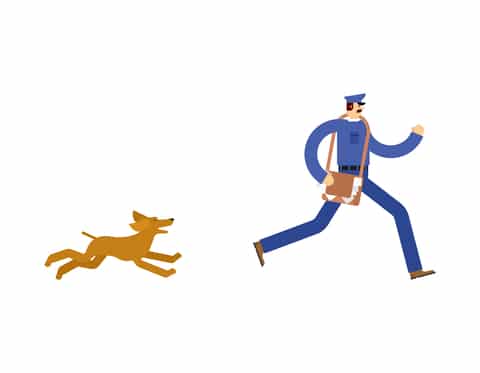Behavior, Everything, Dogs, Training
What to do when Your Dog Chases Cars, Bicyclists, or Joggers
He sees the moving object or person. Or perhaps he sees it or him or her as a threat to his territory. His instinct to chase overcomes him, so he runs after the car, the bus, the truck, the bicyclist, the jogger. Victory! Although he didn’t manage to bring down lunch, he did frighten off the predator.
Why wouldn’t your dog chase moving vehicles or moving people? It’s instinctual, it’s fun, and it’s something he can be successful at every time. The vehicle or jogger always runs away from him in fear.
As people, we of course see the situation differently. Chasing motor vehicles or bicycles could cost a dog his life. While your dog may not hurt joggers, they don’t know that, and eventually, a jogger is going to retaliate. As dog owners, it’s our responsibility to keep dogs from chasing except for toys that they can chase and bring back to us.
How do we keep our dogs from running after cars, bicyclists, or joggers?
Prevention
The safest way to keep your dog from chasing cars or other moving objects is to keep him indoors, in a fenced yard, or on a leash at all times. This is not practical, however, if you live on a large property, or if you take your dog to off-leash parks. You want your dog to be able to run around but not go after anything except what you toss for him.
For your dog’s safety, containment should be used whenever possible. For some dogs, specific training is necessary for those times when they’re off-leash.
Training
Can you train instinct out of a dog? No, but you can train him to obey you above what his instinct tells him to do.
All dogs should be taught to come when called, every time. When dog owners are able to use this command, a lot of chasing incidents can be halted almost right away.
To teach your dog to come on command, start with having him on a long leash, and give him a reward every time he comes. Don’t let him see the reward until he comes to you; you want him to come in anticipation of a reward, not because of what he sees you holding. When he comes, praise him and stroke him, and then offer another reward, such as a treat or play time with his favorite toys. A chance to play is a good inducement to cease from chasing after cars, since it’s the same kind of fun, but with you.
To teach your dog not to chase except on command, you’ll need to enlist the help of a friend. Have your friend jog, bicycle, or drive slowly drive past you. When your dog starts to chase your friend, restrain him with the leash and use the “Off” command. Do this repeatedly over days or weeks until your dog resists the urge to chase, whether or not he’s on-leash.
Be sure to reward your dog for obeying you, and continue to share lots of play time with him. Reinforcement training may be necessary at times.
Intimidation
With some dogs, the predatory instinct is stronger than any training you can give them. The objective with these dogs is to convince them that joggers, bicyclists, and moving motor vehicles are scary. They do not all run away. Instead, some of them turn on you.
Again, you’ll need to enlist the help of a friend. When your dog chases your friend while she’s jogging or bicycling past, have her shout at the dog, wave her arms (if she’s jogging), spray water at the dog, and perhaps throw water balloons at him. With cars, the same procedure works except that the car (preferably one that your dog doesn’t recognize) will need to stop, and a passenger will need to jump out and turn on the dog.
With a lot of time and patience, your dog can learn to chase only toys that you throw for him. As with most training, the younger the dog is when you start, the easier the task will be.


